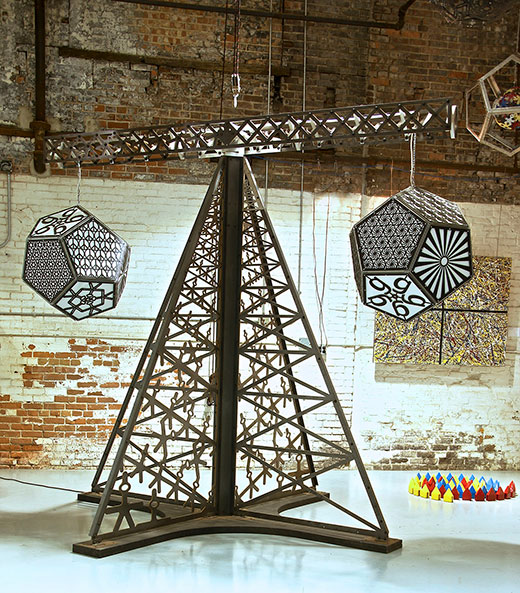 For more than a decade, Joe Richey has been a force to be reckoned with in the arts in Peoria. Most readers know him as the co-director of the Prairie Center of the Arts along with his wife Michele Richey. In 2003, they founded one of the most unique and accommodating artist residencies and exhibition centers in the Midwest. Joe has also been the force behind Peoria’s Sculpture Walk, an equally important project that brings together city leaders and artists and promotes local and regional sculptors to wide audiences.
For more than a decade, Joe Richey has been a force to be reckoned with in the arts in Peoria. Most readers know him as the co-director of the Prairie Center of the Arts along with his wife Michele Richey. In 2003, they founded one of the most unique and accommodating artist residencies and exhibition centers in the Midwest. Joe has also been the force behind Peoria’s Sculpture Walk, an equally important project that brings together city leaders and artists and promotes local and regional sculptors to wide audiences.

Joe Richey’s “BALANCE” is constructed from hot rolled steel, plastic, aluminum and wood. It reflects the sculptor’s investigations into the history of religion, science and philosophy.
His imagination, creativity, intellectual curiosity, ambition and humor is a perfect consolidation of requirements for today’s artist/entrepreneurs, particularly those in the Midwest who must repeatedly define and embolden our cultural environment. The fact that he also runs a highly successful metal manufacturing business with his brother Dan is extraordinary. That he returned to his alma mater, at the young age of over 50, to complete a terminal studio art degree, all the more impressive.
Joe Richey approaches his sculpture armed with technician’s manuals and philosopher’s texts. He addresses significant movements in the history of modernism, particularly those that relate to, as one might guess, technology and manufacturing, and he flavors them with a fairly romantic slant on metaphysics and cosmology.
Joe doesn’t make sculpture in any ordinary sense but builds large-scale movable assemblages — aesthetic de-processing machinery — that approximates segments of projects by Alexander Rodchenko or Walter Gropius who were artists, architects and revolutionaries. He channels Precisionist photographer Ralph Steiner and later the logistical formulas of Frank Stella and Sol Lewitt. It’s not difficult to find formal variations of all of their works embedded in his sculpture but Joe is linked more by conceptual and attitudinal correspondences. All esteem the machine, pattern, power and the object and joins them in privileging mathematics as an intellectual touchstone.
Joe speaks of “tacit knowledge,” that which is only achieved by performing or building and is considered to be one source of codified knowledge. With a craftsman’s reverence for the intrinsic nature of materials, he organizes fragments that reflect design codes and then doubles back to re-intuit them. The process requires patience and planning and has resulted in sculpture like the formidable 10 x 8 x 4 foot “BALANCE,” constructed from hot rolled steel, plastic, aluminum and wood. As with his other works, he employs a computer aided design and manufacturing process known as CAD-CAM to produce a perfectly constructed amalgamation of theory and practice.
“BALANCE” is replete with vivid backlit symbols derived from the sculptor’s investigation into the history of religion, science, and philosophy. The images are organized to convey the significance of a heterogeneous, sometimes contradictory, yet ultimately sustainable world — thanks to Joe’s precise calculations. Tilting on the crown of this construction are mechanical arms that extend like a high voltage tower. Each arm holds a stunningly patterned 12-faced polyhedron, an ancient Greek model for ordering the universe. Polyhedrons are also a favorite formal device and conceptual vessel of Richey’s and are scattered throughout his extraordinary studio on the ground level of the Cordage Building.
While much American industry has been shipped overseas, the public has lost touch with the extraordinariness of the factory and with skilled labor as a way of knowing the world. It’s not only tragic for the American worker, but it’s a loss for the American imagination. Joe’s sculpture resuscitates the narrative that America, and particularly inland America, once feted in the design and manufacturing of tools for agriculture, transportation and architecture. This is the same history that influenced late modernist sculpture in the United States, and Joe acknowledges that work and his own history in Peoria where some of that design and manufacturing originated.
Recently the Prairie Center has scaled back a bit on its operations and its constituencies, even as it continues to address community needs with local artists, public schools and colleges. Consequently, Joe has more time for his own work which has been sheltered below the Prairie Center. His artwork deserves more attention and institutions need to acquire this enigmatic sculpture. Peoria’s visual culture would not be on the map without his vision and tireless efforts to produce contexts for artists and designers to work, but now is the time for Joe’s cosmological machines, rotating in their Euclidean space, to be front and center.
